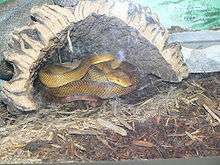Candoia bibroni
Candoia bibroni is a nonvenomous boa species endemic to Melanesia and Polynesia. Two subspecies are currently recognized, including the nominate subspecies described here.[2]
| Candoia bibroni | |
|---|---|
 | |
| Scientific classification | |
| Kingdom: | Animalia |
| Phylum: | Chordata |
| Class: | Reptilia |
| Order: | Squamata |
| Suborder: | Serpentes |
| Family: | Boidae |
| Genus: | Candoia |
| Species: | C. bibroni |
| Binomial name | |
| Candoia bibroni (A.M.C. Duméril & Bibron, 1844) | |
| Synonyms[1] | |
Etymology
The specific name, bibroni, is in honor of French herpetologist Gabriel Bibron.[4]
Description
C. bibroni is the largest member of the genus Candoia; adults can grow to up to 1.5 m (5 ft) in total length (including tail). The color pattern usually consists of a pale brown, tan, or reddish brown ground color overlaid with stripes, blotches, or spots. However, some individuals have no pattern at all.[3]
Distribution and habitat
C. bibroni is found in Melanesia and Polynesia, including the eastern Solomon Islands (Olu Malau, Ugi, Rennell, Makira, Santa Ana, Santa Cruz, Bellona, Vanikoro and Utupua), the Banks Islands (Vanua Lava Island), Vanuatu, all three of the Loyalty Islands, the Fiji Islands (Rotuma, the Yasawa Group and the Lau Group), Western Samoa (Savai'i and Upolu islands), and American Samoa (Ta'u Island).
The type locality given is "l'île Viti" (possibly Viti Levu, Fiji Islands). Jacquinot and Guichenot (1853) list the type locality as "de l'archipel de Viti, Polynésie".[1]
Feeding
The Pacific tree boa hunts for food both on the ground and in the trees, preying on birds, lizards, and mammals, including bats.[3]
Subspecies
| Subspecies[2] | Taxon author[2] | Common name | Geographic range |
|---|---|---|---|
| C. b. australis | (Montrouzier, 1860) | Solomon Islands tree boa | |
| C. b. bibroni | (A.M.C. Duméril & Bibron, 1844) | Pacific tree boa | |
References
- McDiarmid RW, Campbell JA, Touré T (1999). Snake Species of the World: A Taxonomic and Geographic Reference, Volume 1. Washington, District of Columbia: Herpetologists' League. 511 pp. ISBN 1-893777-00-6 (series). ISBN 1-893777-01-4 (volume).
- "Candoia bibroni ". Integrated Taxonomic Information System. Retrieved 14 July 2008.
- Mehrtens JM (1987). Living Snakes of the World in Color. New York: Sterling Publishers. 480 pp. ISBN 0-8069-6460-X.
- Beolens, Bo; Watkins, Michael; Grayson, Michael (2011). The Eponym Dictionary of Reptiles. Baltimore: Johns Hopkins University Press. xiii + 296 pp. ISBN 978-1-4214-0135-5. (Candoia bibroni, p. 25).
Further reading
- Boulenger GA (1893). Catalogue of the Snakes in the British Museum (Natural History). Volume I., Containing the Families ... Boidæ ... London: Trustees of the British Museum (Natural History). (Taylor and Francis, printers). xiii + 448 pp. + Plates I-XXVIII. (Enygrus bibronii, pp. 106–107).
- Dumeril AMC, Bibron G (1844). Erpétologie générale ou Histoire naturelle complète des Reptiles. Tome sixième. Paris: Roret. xii + 609 pp. (Enygrus bibroni, new species, pp. 483–484). (in French).
External links
| Wikimedia Commons has media related to Candoia bibroni. |
- Candoia bibroni at the Reptarium.cz Reptile Database. Accessed 14 July 2008.